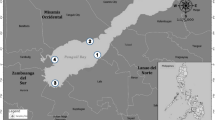Abstract
Juvenile marine polychaetes, Neanthes arenaceodentata, were exposed for 28 days to copper (Cu)-spiked sediment at six concentrations ranging from 48.3 to 2380 mg Cu/kg dry sediment, plus control. Survival was reduced (p ≤ 0.05) at concentrations ≥1190 mg Cu/kg. Growth was inhibited at Cu concentrations ≥506 mg Cu/kg. Dose–response relationships yielded LC10 and LC50 estimates of 514 and 1230 mg Cu/kg, respectively. The growth effect EC50 estimate was 409 mg Cu/kg. Ranges for the no observable effect concentration and lowest observable effect concentration were 506–1190 mg Cu/kg for survival, and 230–506 mg Cu/kg for growth. Pore water concentrations of Cu were 38.7–65.8 µg Cu/L in exposures where toxic effects were observed, compared to a range of 15.1–22.4 µg Cu/L in exposures where significant effects were not evident. The results of the study were compared with empirical and mechanistic sediment quality guidelines for the protection of benthic organisms.
Similar content being viewed by others
References
Ankley GT, DiToro DM, Hansen DJ, Berry WJ (1996) Technical basis and proposal for deriving sediment quality criteria for metals. Environ Toxicol Chem 15:2056–2066
Arnold WR, Cotsifas JS, Winter AR, Klinck JS, Smith DS, Playle RC (2007) Effects of using synthetic sea salts when measuring and modeling copper toxicity in saltwater toxicity tests. Environ Toxicol Chem 26:935–943
ASTM (1999) Standard guide for conducting sediment toxicity tests with marine and estuarine polychaetous annelids. E1611. American Society for Testing and Materials (ASTM), Philadelphia, p 26
ASTM (2003) Standard guide for conducting static acute toxicity tests starting with embryos of four species of saltwater bivalve molluscs. In: E 724–98 Annual book of ASTM standards, Vol 11.05, American Society for Testing and Materials (ASTM), Philadelphia, pp 149–169
Batley GE, Simpson SL (2009) Development of guidelines for ammonia in estuarine and marine water systems. Mar Pollut Bull 58(10):1472–1476
Brumbaugh WG, Besser JM, Ingersoll CG, May TW, Ivey CD, Schlekat CE, Garman ER (2013) Preparation and characterization of nickel-spiked freshwater sediments for toxicity tests: toward more environmentally realistic nickel partitioning. Environ Toxicol Chem 32:2482–2494
Buchman MF (2008) NOAA screening quick reference tables. NOAA OR&R report 08-1, Office of Response and Restoration Division, National Oceanic and Atmospheric Administration, Seattle, p 34
Burgess RM, Berry WJ, Mount DR, Di Toro DM (2013) Mechanistic sediment quality guidelines based on contaminant bioavailability: equilibrium partitioning sediment benchmarks. Environ Toxicol Chem 32(1):102–114
Burton ED, Phillips IR, Hawker DW (2006) Factors controlling the geochemical partitioning of trace metals in estuarine sediments. Soil Sed Contam Int J 15(3):253–276
Campana O, Simpson SL, Spadaro DA, Blasco J (2012) Sublethal effects of copper to benthic invertebrates explained by sediment properties and dietary exposure. Environ Sci Technol 46(12):6835–6842
Chadwick DB, Zirino A, Rivera-Duarte I, Katz CN, Blake AC (2004) Modeling the mass balance of copper in San Diego Bay. Limnol Oceanogr 49(2):355–366
Di Toro DM (2013) The interplay of environmental toxicology and chemistry in the development of sediment quality criteria. Environ Toxicol Chem 32(1):7–9
Gaertner K (2012) Copper: chronic toxicity in whole sediment with a marine polychaete (Neanthes arenaceodentata). Final rep. study no. 65417, ABC Laboratories, Columbia, p 69
Hutchins CM, Teasdale PR, Lee SY, Simpson SL (2008) Cu and Zn concentration gradients created by dilution of pH neutral metal-spiked marine sediment: a comparison of sediment geochemistry with direct methods of metal addition. Environ Sci Technol 42:2912–2918
McPherson CA, Chapman PM (2000) Copper effects on potential sediment test organisms: the importance of appropriate sensitivity. Mar Pollut Bull 40(8):656–665
Santore R, Ryan A, Delos C, Rivera-Duarte I, Rosen G, Earley P (2012) Revision and update of the US ambient water quality criteria for copper in saltwater. 16th Int Congr Mar Corr Foul, Seattle, 22–24 June 2012
Shumilin E, Jimenez-Illescas AR, Lopez-Lopez S (2013) Anthropogenic contamination of metals in sediments of the Santa Rosalia Harbor, Baja California Peninsula. Bull Environ Contam Toxicol 90(3):333–337
Simpson SL, Batley GE (2007) Predicting metal toxicity in sediments: a critique of current approaches. Integr Environ Assess Manage 3:18–31
Simpson SL, Angel BM, Jolley DF (2004) Metal equilibration in laboratory-contaminated (spiked) sediments used for the development of whole-sediment toxicity tests. Chemosphere 54:597–609
Simpson SL, Batley GE, Hamilton IL, Spadaro DA (2011) Guidelines for copper in sediments with varying properties. Chemosphere 85(9):1487–1495
Simpson SL, Ward D, Strom D, Jolley DF (2012) Oxidation of acid-volatile sulfide in surface sediments increases the release and toxicity of copper to the benthic amphipod Melita plumulosa. Chemosphere 88(8):953–961
Strom D, Simpson SL, Batley GE, Jolley DF (2011) The influence of sediment particle size and organic carbon on toxicity of copper to benthic invertebrates in oxic/suboxic surface sediments. Environ Toxicol Chem 30(7):1599–1610
USEPA (2003) 2003 Draft update of ambient water quality criteria for copper. EPA 822-R-03-026. United States Environmental Protection Agency, Washington, DC
USEPA (2005) Procedures for the derivation of equilibrium partitioning sediment benchmarks (ESBs) for the protection of benthic organisms: metal mixtures (cadmium, copper, lead, nickel, silver and zinc). EPA 600/R-02/011. United States Environmental Protection Agency, Washington, DC
Acknowledgments
The authors thank the Copper Development Association for funding this study under contract no. 65417 to ABC Laboratories. Melissa Taylor and Xiaoyan Qin of ABC Laboratories, and Scott Smith of Wilfrid Laurier University are gratefully acknowledged for their technical assistance.
Author information
Authors and Affiliations
Corresponding author
Rights and permissions
About this article
Cite this article
Ward, T.J., Gaertner, K.E., Gorsuch, J.W. et al. Survival and Growth of the Marine Polychaete, Neanthes arenaceodentata, Following Laboratory Exposure to Copper-Spiked Sediment. Bull Environ Contam Toxicol 95, 428–433 (2015). https://doi.org/10.1007/s00128-015-1582-9
Received:
Accepted:
Published:
Issue Date:
DOI: https://doi.org/10.1007/s00128-015-1582-9




